10 Dangerous Self-Care Mistakes We Make When Trusting Beauty Bloggers

Baltic Amber is some of the most common resins found in the world. The “resin” for this is that due to the vast forests of pine, their numerous deposits are so common they provide wonderful treasures from long ago.
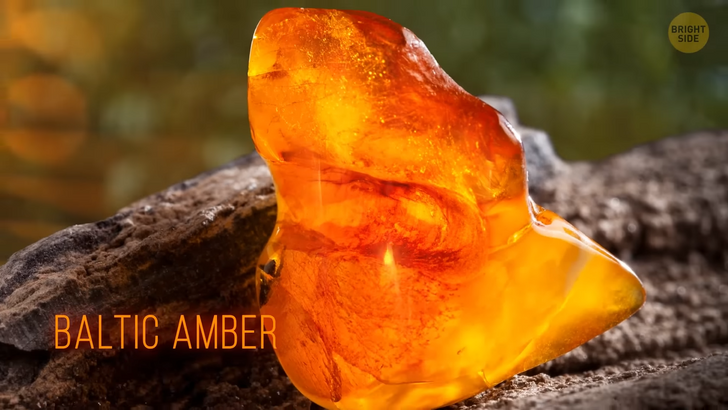
Ants are especially common in the Baltic amber which comes from pine trees. Its resin is rich in sugar, so the ants often live amongst the trees, close to the easy source of food. One block found in East Germany has preserved one Ant that is estimated to be about 48 million years old. Think of the birthday cake! But what makes this find interesting is another animal inside the amber. It’s a mite, notorious hunters in the insect world, capable of traveling at great speed. These guys quickly latch onto their hosts, sucking them dry. They’re also capable of destroying entire hives in one go. And within this piece of amber, the amber provides a display of their final struggle.
In Southeast Asia, feathers belonging to something unique have been found from 80 million years ago. They were captured in resin during the Cretaceous period, a peak time for dinosaurs. The many feathers inside are from the Coelurosaur. It looks like a dinosaur, but this animal is more related to birds. Other feathers like this have been found in resin, they belonged to avian and other non-flying Dinosaurs. The discoveries have helped re-imagine what dinosaurs actually looked like.
Still, dinosaurs may have had feathers instead of being completely bald. Of course, for most of them, the feathers weren’t used for flying, but they helped dinos stay warm. However, the feathers weren’t all that was found, and a part of the Coelurosaurs tail is also preserved. Still, it’s so small and ancient that its DNA hasn’t survived to map their entire genome. The enclosed tail is also very delicate, and it can’t be removed from its protective amber shell. But although these findings can only be observed, they’ve still provided a great insight into the evolution of birds.
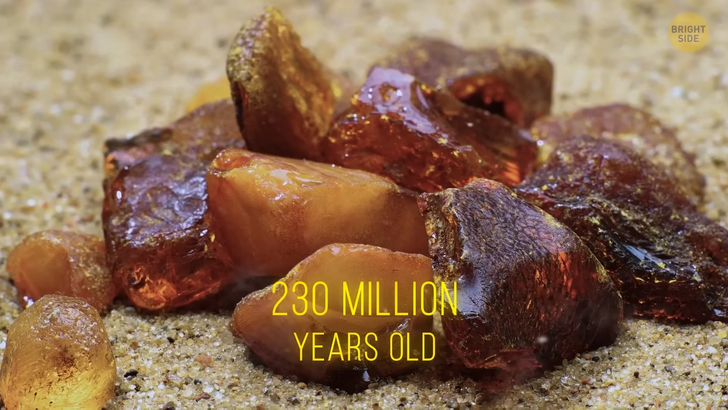
But how does amber preserve things so effectively, even at the initial stages? The trees produce the resin to protect any small gaps in the bark, against feeding insects. Its antiseptic nature and lack of water content ensures it doesn’t degrade for a long time. This also makes it more resilient as it petrifies over long periods, eventually becoming a fossil. Some of the oldest amber ever found was from the Triassic period, showing how long it can last.
The pieces from Italy are about 230 million years old! And inside one of these ancient droplets, holds the oldest arthropod ever recorded. This mite found inside has provided a broader understanding of their evolution. Today they’re known to mainly annoy gardeners by feeding on the petals of flowering plants. However, at the time the mite was caught, flowers didn’t have any petals. And it would be without this tasty meal for another 100 million years!
100 million years ago Myanmar was part of Gondwana, the great supercontinent. At that time Myanmar wasn’t part of Asia yet. But it was still lush with a great forest, which contained many species of lizards that lived amongst the undergrowth, hiding away from dinosaurs. Many of them have been stored within amber. This fact has helped discover the ancestors of geckos and chameleons.
By using CT scans, scientists have analyzed them, giving a glimpse into the formation of their scales, teeth, feet, and claws. It all provided an understanding of how these archaic creatures once appeared. Although mostly pieces of lizards, by using modern technology scientists have been able to create 3D images of the lizards. These images can reveal how those guys appeared in their full form. The images show that they still retain some of their exact features to this day, like the chameleons’ sticky pads used for climbing!
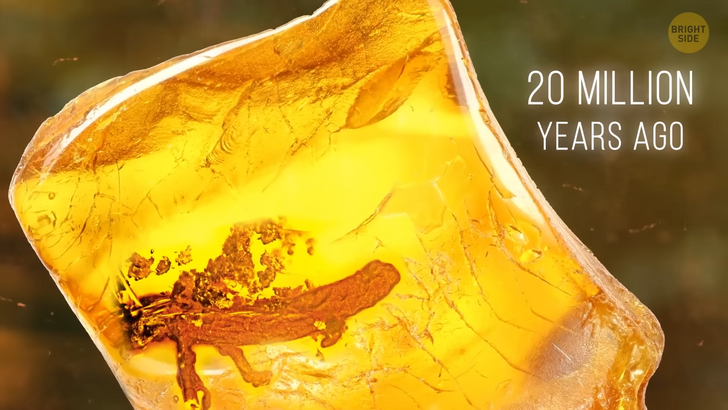
A Salamander fossil from around 20 million years ago is one of the most intact specimens ever found in amber. Details of its final moments show that it had been attacked before getting stuck in the resin. However, what’s confusing about this find from the Miocene era, is that the amber was found in the Caribbean. But it came from a tree that’s closer related to those from East Africa. The lizard also has ancestry from the same area. Finds like this have opened a whole new understanding of how these small lizards migrated. It’s expected that they would have ridden fallen logs, which took them across the seas to new homelands. Not only to the Caribbean but to all continents except for Antarctica. Nobody goes there. It’s too cold.
In the Dominican Republic, you can find some of the rarest of all ambers. This Dominican amber came from neotropical forests from around 20 million years ago. Many of the trees that made the resin are now extinct. The amber is almost completely see-through and can come in an array of beautiful colors. The most common colors are red, yellow, and even blue, and are easily mistaken for gemstones. One was found with a flea caught in it, dating to when the forest was at its peak and the mammalian variety thrived.
Fleas were likely common at the time, and this flea in particular had recently fed on a mammal before getting stuck. However, something more intriguing was found within the flea. While scientists checked what mammal DNA was within the flea, they found that it was carrying an ancient bacterial blight. These blights have been constant throughout Earth’s history, dramatically decreasing populations of animals and plants. This now extinct blight in the amber helped scientists determine how much the bacteria have evolved and how it spread.
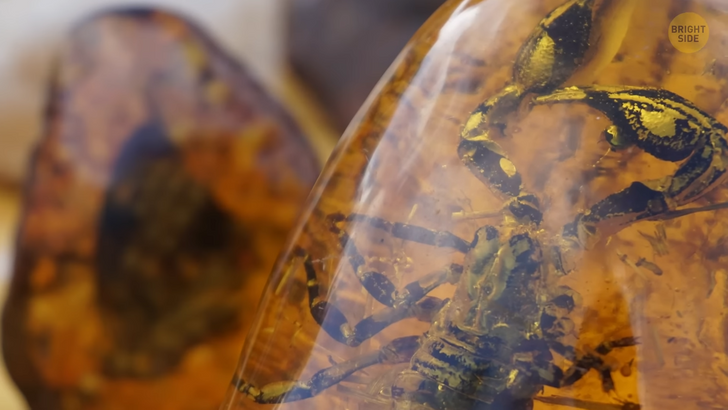
Most remnants of insects inside amber aren’t much more than the exoskeleton bodies. But with some found in Myanmar, they were so well-preserved that even the color of the insects is still intact. Colors in nature appear in three different ways. The first is bioluminescence that’s produced by a chemical reaction within a living organism. The second is about pigments, where the color appears in an animal or plant tissue. The third is called structural coloration, and the production of colors here is explained by microscopic surfaces fine enough that react with the light.
The rare insects in amber were found in the form of structural coloration, but only at specific wavelengths. It all explains the very intense colors rarely found. 99 million years later these bugs can still show their vibrant colors — blue, purple, and green. Some of them appear so different in color and shape that they almost look like they’re from another world. Which of course, they are. A very old one.
Ants have been around for around 168 million years, based on fossil evidence provided. They’re well known for their social hierarchies and their hive-mind system. They have dominated almost every corner of the insect world. But when these social capabilities came about have been difficult to determine. Yet recently, amber dated from 100 million years ago has shed some light on their evolution. Several amber pieces have preserved various ant types, including the worker ants, guardian, or soldier ants, and even a queen ant. Before these pieces were found, it was estimated their social nature occurred millions of years later.
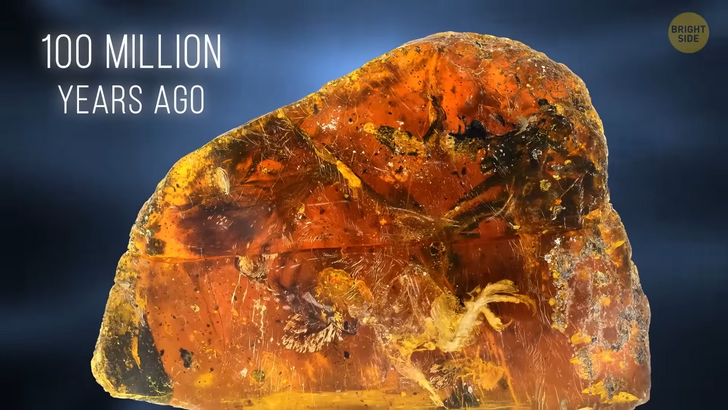
A piece of amber dated 100 million years ago helps shed light on the evolution of birds. A perfectly preserved bird that hatched preserved in amber, was already equipped with its flight feathers. With the earlier physical abilities, they would be capable of moving around the nest by themselves at a very young age. And it’s expected they could search for their own food almost immediately. But as birds continued to evolve and spend more time in the skies, their brain developed larger for their cognitive abilities. After hatching, their early development was then more focused on the brain. And the chicks slowly became more reliant on their parents over time.
In Spain, a massive treasure trove of amber and other fossils has been found. Inside, there were remnants of an entire ecosystem that existed 110 million years ago. A bunch of individual fossils were found. The vast collection includes many types of insects, mollusks, arachnids, plants, 50 different dinosaur bone fragments, feathers, and hair from mammals. With the abundance of findings, it’s helped researchers understand the ancient terrestrial ecosystem that once existed. With loads of specific details of the environment, they’ve reconstructed the swamp. This way, it’s now possible to experience what it was like in the world of dinosaurs.











